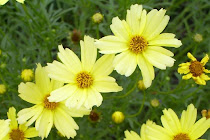
So, this year, as they started coming up, I pulled out almost all of them. Yes, I did leave a few. Because they are pretty and they do make a nice accent.

You may have heard of the sensitive plant (Mimosa pudica). If you touch its leaves, they curl up. The leaves of the sensitive plant do look similar this plant, but the sensitive plant has pinkish-lavender pom-pom type flowers and my weed (Cassia fasciculata or Partridgepea) has the yellow flowers pictured.

Before I did my research as to the weed's botanical name, and discovered that it wasn't a Mimosa as I had mistakenly thought, I tried touching its leaves to see what happened. Well, after stroking this leaf for a minute or so, look what occurred! I guess maybe it is a little bit sensitive, too.

And I couldn't resist adding another butterfly-on-a-sunflower picture. Enjoy.
 Have a beautiful day!
Have a beautiful day!







.jpg)


4 comments:
i didn't know about partridge pea! it is pretty. i would have wanted to leave it alone, too. i just read that it's an important honey plant. and not actually in the pea family. i'll have to keep my eye out for it. thanks for the introduction!
Hi, Daricia, It is in the Family Leguminosae and it produces a sort of flattened pea-type pod that holds the seeds. Lots of 'em! There were a couple of different types of bees on it when I was taking pictures. Honey plants are always good! :)
Hi, again! One book I have puts it in the Family Leguminosae but Dave's Garden puts it in Caesalpiniaceae, so I don't know which it is "officially"! :) Anyhow, it is pretty! :)
If you want to grow the very sensitive plant that MOVES when you Tickle It. Just search TickleMe Plant. Now it can be grown indoors year round
Post a Comment